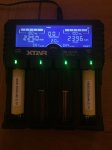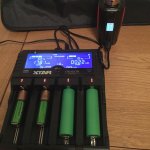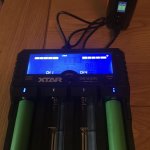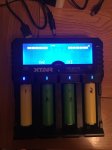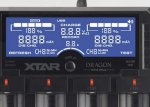KingPin!
In my defence, I was left unsupervised ^^
VU Donator
Platinum Contributor
Member For 4 Years
VU Challenge Team
Reviewer
Hi Folks,
I received the Dragon VP4 Plus directly from XTAR. This is available to buy now. I will convey my thoughts and do my very best to provide you with enough information so you can reach your own conclusion on the product, so no recommendations from me, just a final conclusion of my personal experience with it. Please ask questions in the below if I've missed anything you want to know
What Do You Get?
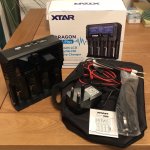
This is XTAR’s flagship charger; it’s got all the bells and whistles I’d expect to see on a premium model, and the price of the charger £70”ish” reflects that. No you don’t get silver plating or a butler to load your batteries for you. Instead you get a better storage bag, both mains power and car charging cords included and finally a couple of “probes” (not the types the aliens use!). How is getting a plug a bonus I hear you ask? Well if you buy one of XTAR’s USB chargers in the budget to affordable range you don’t get one as standard.
The main difference for the hefty price jump is the functionality the charger provides under the hood, supporting adaptive peripheral charging, testing, refreshing, multi-meter checks and even acting as a power bank should you have a power cut. So if you like to geek out continue on otherwise you are probably better off taking a look at the Nitecore D4 vs XTAR VC4 review I dropped, both charges are “plug and play” and are excellent chargers to use.
I think the best way to go through this review is to list the manufacturer specs and let you know my experiences with each. Before I jump onto that I want to discuss the user manual because it’s relevant to every part of this review (Plus I don’t want to keep bringing it up). I found the manual to be severely lacking. I’d expect a book to come with the Dragon VP4. But you don’t get that, instead you receive a simple fold out with no explanation as to how best use each feature or when to select certain options. Lastly there is no “how best to interpret the results” and look for signs batteries need replacing. Perhaps XTAR expect a certain degree of up front user knowledge, although I believe it’s a big oversight on their part.

Manufacturer Specs and Review
The Dragon is Compatible with:
Li-ion (supports IMR, INR, and ICR Chemistry 3.6/3.7v) - Sizes: 10440, 14500, 14650, 16340, 17335, 17500, 17670, 18350, 18490, 18500, 18650, 18700, 20700, 21700, 22650, 25500, 26650, 32650
Ni-MH & Ni-CD - Sizes: AAAA, AAA, AA, A, SC, C, D,
Battery Pack: 11.1V/3S
So it’s safe to say it supports a large range of batteries. The charger itself is a beast in size, dwarfing the XTAR VC4 charger. However the payoff is increased venting and ability to insert and remove batteries with ease, as well as charge peripheral devices at the same time. If you are after something small and compact look away now this is not what you are looking for.
It doesn’t support IFR chemistry, though I believe none of the mainstream XTAR chargers support this. Also I’m not confident it supports RCR123 “3V” Li-ion 800mAh cells either being it lists 3.6/3.7V support only. Ordinarily I’d say these things are a moot point for vapers as we will all be using IMR, INR, and NMC chemistries for the most part, but for a flagship product with the associated price tag this has got to be listed as a con. If you’re charging a premium and it’s your flagship charger it needs to offer compatibility with everything the competitors do in my opinion.
I’d really like to see XTAR build a feature into their chargers that can automatically detect lower charging needs for some Li-ion batteries and present this differently on screen. It’s something Nitecore offers on its affordable range (albeit manual).
Battery Chemistry Key:
Even so I would like to have seen support for a wider range of battery packs. For me it’s the whole flagship argument again, at least offer 4S in addition since it’s a 4 bay charger anyway. Perhaps the reason the Dragon VP4 Plus doesn’t support a larger battery pack is because it’s not fan cooled. So if like me, you decide to load it up with 4 batteries, a mod that contains 3 18650’s charging through the USB and also plug in a 4S/6S battery pack, it might start to get a bit on warm pushing you towards the Darwin Award for human endeavours. However surely it wouldn’t be beyond the wit of man to display an error message or to divert power to what’s needed intelligently?
I can hear the techies snubbing me now “stupid idiot” hey this is an end user review, I don’t care about the journey, just the end result.
Choose Your Charge level: 0.5A, 1A or 2A
Depending on the slots you use, you can manually choose between 0.5, 1 or 2 Amp charging by clicking on the current/refresh button. It doesn’t matter adjusting it whilst it’s in the middle of charging either. As with many chargers on the market, to access that full 2A you will be resigned to using only the two outer bays only. Should you use the middle slots or load more than two cells at once it won’t allow you to pass 1A.
Changing the charge level is only relevant to the battery bays. Should you try to use USB or Battery Pack ports, changing this on screen charge rate has no influence as to how the charger approaches peripheral devices/ Li-Po’s. Additionally there is no way to select charge rate on each individual bay, so if you are doing a mix and match charge for example: AAA and 20700 cells at the same time, bear in mind what you choose is global.
I can’t really grumble here overall. It smashed through charge cycles really well. For vaping I do only use 18650’s at present, so without any way to discharge bigger batteries all my testing and observations has been recorded whilst using them.
18650 4.2V Results (averages recorded using Samsung 30Q, LG HE4, Sony VTC5A)
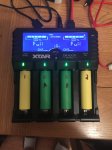
I didn’t notice any significant changes in time to charge when loading it up with more than two batteries at a time. So these times were an average across the board. Also note I was using both 3000mAh and 2500mAh batteries for these averages so your times may vary slightly depending on what batteries you use.
Is this manual selection suitable for every occasion? I can see it now, let’s put on a little battery and whack it up to the max baby! No I wouldn’t say it’s suitable using 2A charging in all cases, all of the time. Regardless the charger doesn’t restrict your decision (think your 1.2v Ni-MH batteries here). But even if you do select 2A, you won’t know what’s really going on without hooking up some sort of external equipment. Much like XTAR’s VC4 & VC2 chargers, what’s shown on screen is not a live readout. The current readout you are seeing is the maximum possible rather than what it’s currently charging against each charge bay. As it goes through its charge cycle (trickle, constant current then constant voltage) the current will be changing in the background.
If like me you are the kind of person who likes to know what’s happening this is going to irritate you. They need to have a button that says “I don’t care mode” and “hell give me everything mode” to cater for everyone. I’m willing to make a bet here the kind of people who will be looking to buy this charger are the ones that care about the stats.
Finally in this section I want to talk about how the charger completes its cycle. I found some of the time when it terminates a cycle, using the probes it reads 4.19V and not 4.2V. Just to check I used Samsung 30Q, Sony VTC5A and LG HE4’s. It didn’t matter what cell type I was using results were consistent for early termination. Just to make sure it wasn’t just inaccuracies in using the Dragon’s multi meter probes, I placed all 4 batteries in the XTAR VC4 charger. Some would go green instantly and others continued to charge for a few minutes with an additional 10-20mAh capacity.
I received the Dragon VP4 Plus directly from XTAR. This is available to buy now. I will convey my thoughts and do my very best to provide you with enough information so you can reach your own conclusion on the product, so no recommendations from me, just a final conclusion of my personal experience with it. Please ask questions in the below if I've missed anything you want to know
What Do You Get?
- XTAR Dragon VP4 Plus charger
- Mains plug (mine is UK 3 pin)
- VP4 Charger Pouch
- Multi-meter Probes
- 3A Car Adaptor
- User Manual
- Warranty Card

This is XTAR’s flagship charger; it’s got all the bells and whistles I’d expect to see on a premium model, and the price of the charger £70”ish” reflects that. No you don’t get silver plating or a butler to load your batteries for you. Instead you get a better storage bag, both mains power and car charging cords included and finally a couple of “probes” (not the types the aliens use!). How is getting a plug a bonus I hear you ask? Well if you buy one of XTAR’s USB chargers in the budget to affordable range you don’t get one as standard.
The main difference for the hefty price jump is the functionality the charger provides under the hood, supporting adaptive peripheral charging, testing, refreshing, multi-meter checks and even acting as a power bank should you have a power cut. So if you like to geek out continue on otherwise you are probably better off taking a look at the Nitecore D4 vs XTAR VC4 review I dropped, both charges are “plug and play” and are excellent chargers to use.
I think the best way to go through this review is to list the manufacturer specs and let you know my experiences with each. Before I jump onto that I want to discuss the user manual because it’s relevant to every part of this review (Plus I don’t want to keep bringing it up). I found the manual to be severely lacking. I’d expect a book to come with the Dragon VP4. But you don’t get that, instead you receive a simple fold out with no explanation as to how best use each feature or when to select certain options. Lastly there is no “how best to interpret the results” and look for signs batteries need replacing. Perhaps XTAR expect a certain degree of up front user knowledge, although I believe it’s a big oversight on their part.

Manufacturer Specs and Review
The Dragon is Compatible with:
Li-ion (supports IMR, INR, and ICR Chemistry 3.6/3.7v) - Sizes: 10440, 14500, 14650, 16340, 17335, 17500, 17670, 18350, 18490, 18500, 18650, 18700, 20700, 21700, 22650, 25500, 26650, 32650
Ni-MH & Ni-CD - Sizes: AAAA, AAA, AA, A, SC, C, D,
Battery Pack: 11.1V/3S
So it’s safe to say it supports a large range of batteries. The charger itself is a beast in size, dwarfing the XTAR VC4 charger. However the payoff is increased venting and ability to insert and remove batteries with ease, as well as charge peripheral devices at the same time. If you are after something small and compact look away now this is not what you are looking for.
It doesn’t support IFR chemistry, though I believe none of the mainstream XTAR chargers support this. Also I’m not confident it supports RCR123 “3V” Li-ion 800mAh cells either being it lists 3.6/3.7V support only. Ordinarily I’d say these things are a moot point for vapers as we will all be using IMR, INR, and NMC chemistries for the most part, but for a flagship product with the associated price tag this has got to be listed as a con. If you’re charging a premium and it’s your flagship charger it needs to offer compatibility with everything the competitors do in my opinion.
I’d really like to see XTAR build a feature into their chargers that can automatically detect lower charging needs for some Li-ion batteries and present this differently on screen. It’s something Nitecore offers on its affordable range (albeit manual).
Battery Chemistry Key:
- IMR = (LiMn2O4) Lithium manganese oxide (LG HE2 & HE4)
- INR = (LiNiMnCoO2) Lithium manganese nickel (Samsung 25R & 30Q, LG HG2, IJoy 20700, Sony uses NMC – cobalt in the mix as well I believe in its VTC range)
- ICR = (LiCoO2) Lithium cobalt oxide
- IFR = (LiFePO4) Lithium iron phosphate
- Ni-MH = Nickel-metal hydride
- Ni-Cd = nickel oxide hydroxide and metallic cadmium
Even so I would like to have seen support for a wider range of battery packs. For me it’s the whole flagship argument again, at least offer 4S in addition since it’s a 4 bay charger anyway. Perhaps the reason the Dragon VP4 Plus doesn’t support a larger battery pack is because it’s not fan cooled. So if like me, you decide to load it up with 4 batteries, a mod that contains 3 18650’s charging through the USB and also plug in a 4S/6S battery pack, it might start to get a bit on warm pushing you towards the Darwin Award for human endeavours. However surely it wouldn’t be beyond the wit of man to display an error message or to divert power to what’s needed intelligently?
I can hear the techies snubbing me now “stupid idiot” hey this is an end user review, I don’t care about the journey, just the end result.
Choose Your Charge level: 0.5A, 1A or 2A
Depending on the slots you use, you can manually choose between 0.5, 1 or 2 Amp charging by clicking on the current/refresh button. It doesn’t matter adjusting it whilst it’s in the middle of charging either. As with many chargers on the market, to access that full 2A you will be resigned to using only the two outer bays only. Should you use the middle slots or load more than two cells at once it won’t allow you to pass 1A.
Changing the charge level is only relevant to the battery bays. Should you try to use USB or Battery Pack ports, changing this on screen charge rate has no influence as to how the charger approaches peripheral devices/ Li-Po’s. Additionally there is no way to select charge rate on each individual bay, so if you are doing a mix and match charge for example: AAA and 20700 cells at the same time, bear in mind what you choose is global.
I can’t really grumble here overall. It smashed through charge cycles really well. For vaping I do only use 18650’s at present, so without any way to discharge bigger batteries all my testing and observations has been recorded whilst using them.
18650 4.2V Results (averages recorded using Samsung 30Q, LG HE4, Sony VTC5A)

- 2/3/4 Cells at 0.5A charge time = 5 hours 40 minutes
- 2/3/4 Cells at 1A charge time = 2 Hours 40 minutes
- 2/3/4 Cells at 2A charge time = 1 Hour 20 minutes
I didn’t notice any significant changes in time to charge when loading it up with more than two batteries at a time. So these times were an average across the board. Also note I was using both 3000mAh and 2500mAh batteries for these averages so your times may vary slightly depending on what batteries you use.
Is this manual selection suitable for every occasion? I can see it now, let’s put on a little battery and whack it up to the max baby! No I wouldn’t say it’s suitable using 2A charging in all cases, all of the time. Regardless the charger doesn’t restrict your decision (think your 1.2v Ni-MH batteries here). But even if you do select 2A, you won’t know what’s really going on without hooking up some sort of external equipment. Much like XTAR’s VC4 & VC2 chargers, what’s shown on screen is not a live readout. The current readout you are seeing is the maximum possible rather than what it’s currently charging against each charge bay. As it goes through its charge cycle (trickle, constant current then constant voltage) the current will be changing in the background.
If like me you are the kind of person who likes to know what’s happening this is going to irritate you. They need to have a button that says “I don’t care mode” and “hell give me everything mode” to cater for everyone. I’m willing to make a bet here the kind of people who will be looking to buy this charger are the ones that care about the stats.
Finally in this section I want to talk about how the charger completes its cycle. I found some of the time when it terminates a cycle, using the probes it reads 4.19V and not 4.2V. Just to check I used Samsung 30Q, Sony VTC5A and LG HE4’s. It didn’t matter what cell type I was using results were consistent for early termination. Just to make sure it wasn’t just inaccuracies in using the Dragon’s multi meter probes, I placed all 4 batteries in the XTAR VC4 charger. Some would go green instantly and others continued to charge for a few minutes with an additional 10-20mAh capacity.
Last edited:

